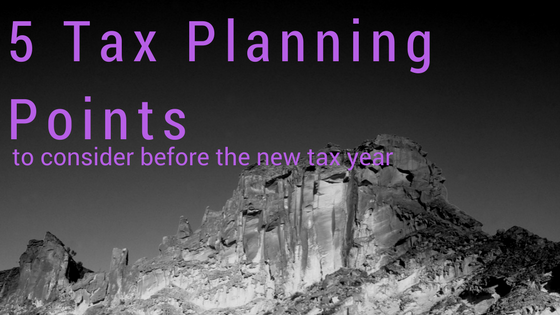On 06/03/24 Chancellor Jeremy Hunt presented his Spring Budget to… Read More
5 tax planning points to consider before the new tax year

Following on from our last blog on New Year Tax Saving Resolutions (click here) and with a few weeks to go until the end of the 2017/18 tax year here are 5 things to think about doing before then:
ISAs
There is a £20,000 limit for ISAs in 2017/18 which can be invested in cash or shares. Any income via interest or dividends from these will be tax free as well as any gains within a share portfolio.
The interest rate is often not the highest and there is an argument that with the savings allowance (£1,000 for basic rate payers, £500 for higher rate tax payers but £0 for additional rate payers) that there is no need for ISAs. However, if you have interest from a director’s loan account, or significant savings then these are still a worthwhile consideration.
The fact that all income and capital is kept within a tax-free wrapper for future years (until you withdraw it) makes it a tax saving vehicle worth using.
Pensions
Making pension contributions remains a tax-efficient way of saving for retirement, with tax relief given at your highest marginal rate of income tax.
The relief is restricted to the lower of the annual allowance, currently £40,000 for most people, or your net relevant earnings (which is something to consider for additional tax rate earners).
There may also be unused annual allowance from the three previous tax years which can be utilised.
If you are a business owner, your company can make contributions on your behalf directly into a pension scheme, which will also reduce its corporation tax bill.
Note that the maximum relief (e.g. £40,000) is ALL pension contributions in a tax year (from both an individual and an employer).
Things to be wary of are the net relevant earning for higher earners, a lifetime cap if your value of pension pot is nearing £1,000,000 and reviewing your carry back pension position.
Talking to your IFA is recommended for pension planning.
Charitable Donations
Gift aid donations to charity give tax relief at your highest marginal tax rate.
Regular donations are easy to note from your bank statements but any adhoc donations to charity can also be claimed.
With the Manchester and London marathons coming up soon and many other charity events arising, it is a good time to gift aid money.
If this is done by Just Giving, Virgin money giving or other similar sites, then you usually receive an email or can logon to your account and see what donations you have made in the tax year.
Any donations made before 31 January of the following tax year, or the date of the submission of your tax return if earlier, can be carried back to the previous tax year. Cash donations made before both 31 January 2019 and the submission of your 2017/18 tax return can be included on your 2017/18 tax return.
Inheritance tax
Gifts of £3,000 can be made annually with no impact on the nil rate band of £325,000 or inheritance tax charge. If you don’t reach the £3,000 limit in one tax year, the balance can be carried forward, but only for one tax year. So, if no gifts were made in 2016/17, you can make £6,000 worth of gifts before 05/04/18.
In the 2017/18 tax year, there will be a new transferable Inheritance Tax (IHT) allowance called the ‘Residence Nil Rate Band’ (RNRB), worth £100,000, for those that want to pass on their main home to their children.
The new band will sit on top of the existing IHT Basic Nil Rate band of £325,000 (£650,000 for married couples/civil partnerships). The maximum available amount will go up yearly.
For deaths in the following tax years it will be:
£125,000 in 2018 to 2019
£150,000 in 2019 to 2020
£175,000 in 2020 to 2021
The change means individuals passing on a main residence may get a tax-free threshold worth £425,00 and couples may be able to pass on estate worth £850,000 without attracting the 40% IHT tax charge.
There are also reliefs on small gifts to any one person of up to £250 annually and gifts out of the transferor’s surplus income, although various conditions must be met such as ensuring the gifts are not putting the donor in a position where they cannot maintain their current standard of living.
Capital Gains Tax
There is an annual exemption for CGT of £11,300 for 2017/18 for individuals.
Spouses or civil partners may consider transferring assets to ensure that they both utilise their annual exemption. It may also be worth considering how any gains above this are being taxed, to make maximum use of any unused income tax basic rate band if one of them is a higher rate taxpayer.
The timing of asset disposal is also important so that the annual exemption is utilised each year rather than disposing of a multitude of assets in one tax year and not utilising the next years allowance.
If you would like to talk to the Moore Accountancy team before the end of March to discuss any of the above, then please contact us at info@mooreaccountancy.co.uk.





Follow Moore Accountancy – Accountants Manchester, Manchester Accountancy Practice